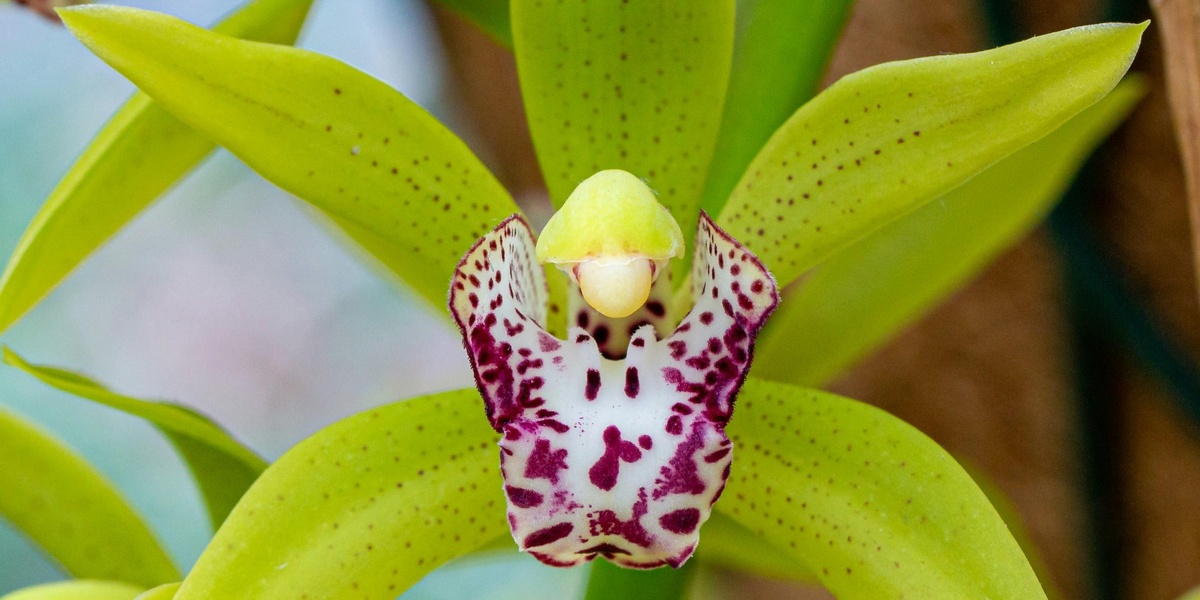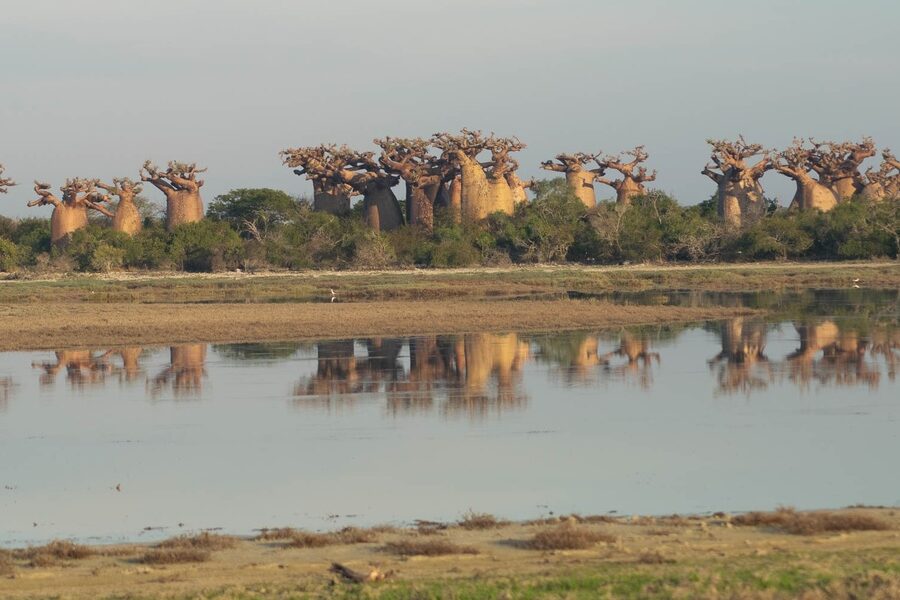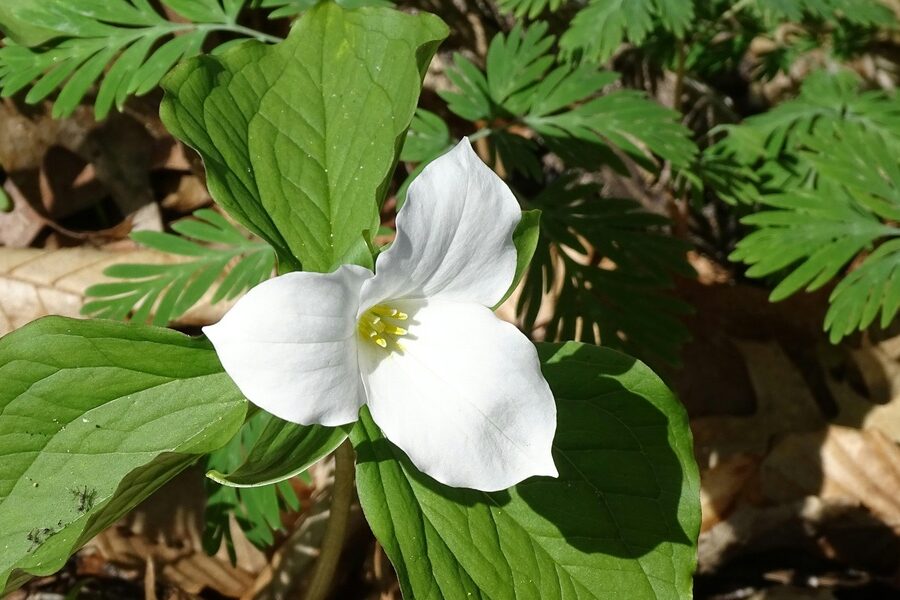Ecuador’s varied landscapes — from coastal plains and Andean slopes to Amazon lowlands and the Galápagos — create a patchwork of habitats where many plant species thrive. Whether you’re walking a cloud forest trail or visiting a community garden, the country’s floral diversity is easy to spot if you know what to look for.
There are 50 Flowers of Ecuador, ranging from Achiote to Zaragoza. For each entry we show Scientific name,Region,Bloom time (months) so you can quickly see where and when each species is most likely to appear; you’ll find below.
When is the best time to see these flowers in Ecuador?
Bloom times vary by elevation and region: lowland Amazon species often flower during or after the rainy season, while Andean and highland species may bloom in specific months tied to local wet/dry patterns. Use the Bloom time (months) column and the Region notes to match locations with peak displays.
How can I use this list to plan a visit?
Use the Scientific name to confirm IDs with local guides or apps, combine Region and Bloom time (months) to pick destinations and dates, and check protected-area access and local weather forecasts; small changes in altitude can shift bloom windows, so allow flexible timing.
Flowers of Ecuador
| Name | Scientific name | Region | Bloom time (months) |
|---|---|---|---|
| Chuquiragua | Chuquiraga jussieui | Andean páramo | Jun–Sep |
| Monkey Face Orchid | Dracula simia | Andean cloud forest | Year-round |
| Frailejón | Espeletia pycnophylla | Andean páramo | Dec–Feb |
| Besse’s Slipper Orchid | Phragmipedium besseae | Andean cloud forest | Varies; often spring |
| Hot Lips Plant | Psychotria elata | Amazon/Cloud forest | Dec–Mar |
| Angel’s Trumpet | Brugmansia sanguinea | Andes | Year-round |
| Ceibo | Ceiba trichistandra | Coastal dry forest | Jan–Apr |
| Guayacán | Handroanthus chrysanthus | Coastal dry forest | Jan–Feb |
| Andean Lupin | Lupinus mutabilis | Andes | Jun–Oct |
| Darwin’s Daisy Tree | Scalesia pedunculata | Galápagos highlands | Year-round |
| Lobster Claw Heliconia | Heliconia rostrata | Amazon/Coast | Year-round |
| Flor de Mayo | Cattleya maxima | Coast/Amazon foothills | Apr–Jul, Nov–Jan |
| Vampire Orchid | Dracula vampira | Andean cloud forest | Year-round |
| Puya | Puya aequatorialis | Andean slopes | Varies |
| Galápagos Cotton | Gossypium darwinii | Galápagos lowlands | Year-round |
| Crucifix Orchid | Epidendrum secundum | Andes | Year-round |
| Princess Flower | Tibouchina lepidota | Andean cloud forest | Year-round |
| Andean Passion Flower | Passiflora mixta | Andes | Year-round |
| Lava Cactus | Brachycereus nesioticus | Galápagos lava fields | Sporadic |
| Andean Blueberry | Vaccinium floribundum | Andean páramo | Year-round |
| Giant Andean Lily | Bomarea caldasii | Andean cloud forest | Mar–Aug |
| Andean Gentian | Gentianella cernua | Andean páramo | Jul–Dec |
| Masdevallia Orchid | Masdevallia coccinea | Andean cloud forest | May–Jul |
| Kapok Tree | Ceiba pentandra | Amazon/Coast | Dec–Feb |
| Dancing-Lady Orchid | Oncidium barbatum | Coast/Andean foothills | Year-round |
| Frangipani | Plumeria rubra | Coastal dry forest | Year-round |
| Cutleaf Daisy | Lecocarpus pinnatifidus | Galápagos (Floreana) | Jan–Apr |
| Spiral Ginger | Costus amazonicus | Amazon | Year-round |
| Flamingo Flower | Anthurium andraeanum | Andean/Coastal wet forest | Year-round |
| Andean Valerian | Valeriana pyramidalis | Andean páramo | May-Sep |
| Sunrose | Helianthemum glomeratum | Andean páramo | Jun-Sep |
| Amazon Lily | Eucharis amazonica | Amazon | Varies, often after rain |
| Spider Orchid | Brassia lanceana | Amazon | Jul-Oct |
| Galápagos Lantana | Lantana peduncularis | Galápagos | Year-round |
| Giant Lobelia | Lobelia gigantifolia | Andean páramo | Dec-Mar |
| Q’uingo | Fuchsia loxensis | Andean cloud forest | Year-round |
| Silver-leafed Bromeliad | Tillandsia argentea | Coastal dry forest | Apr-Jul |
| Quishuar | Buddleja incana | Andes | May-Aug |
| Amazon Passion Flower | Passiflora vitifolia | Amazon | Year-round |
| Miconia | Miconia robinsoniana | Galápagos highlands | Jun-Dec |
| Sobralia Orchid | Sobralia gloriosa | Andean cloud forest | Varies |
| Peruvian Lily | Alstroemeria aurea | Andes | Nov-Feb |
| Flor de Balsa | Ochroma pyramidale | Coast/Amazon | Year-round |
| Cocoa Flower | Theobroma cacao | Amazon/Coast | Year-round |
| Achiote | Bixa orellana | Amazon/Coast | Year-round |
| Lady’s Slipper | Cypripedium calceolus | Andes | May-Jul |
| Canary Bird Vine | Tropaeolum peregrinum | Andes | Jun-Sep |
| Coffee Flower | Coffea arabica | Andean foothills | Varies, after rain |
| Passion Fruit Flower | Passiflora edulis | Widespread | Year-round |
| Zaragoza | Alonsoa meridionalis | Andes | Year-round |
Images and Descriptions
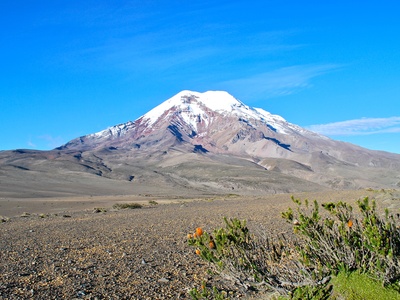
Chuquiragua
Ecuador’s national flower, this hardy shrub has striking orange, thistle-like flower heads. Known as the “flower of the Andes,” it’s a common sight for hikers in high-altitude grasslands above 3,000 meters, especially in Cotopaxi and Cajas National Parks.
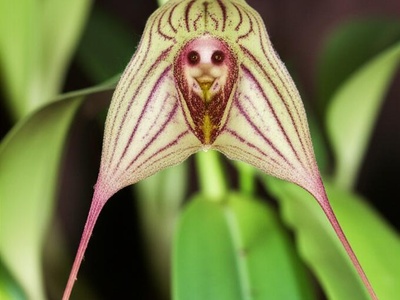
Monkey Face Orchid
Famed for its uncanny resemblance to a monkey’s face, this rare orchid is a prized find for enthusiasts. It grows in the cool, moist cloud forests of southeastern Ecuador at altitudes of 1,000 to 2,000 meters.
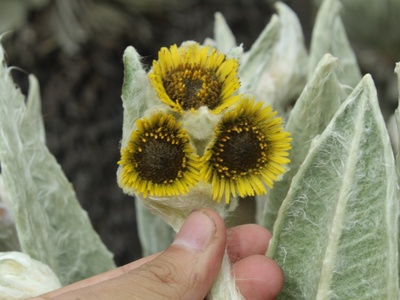
Frailejón
A signature plant of the northern Andean páramo, its thick, hairy leaves protect it from the cold. It produces a tall stalk of bright yellow, daisy-like flowers. Look for them in the Carchi province, especially El Ángel Ecological Reserve.

Besse’s Slipper Orchid
A spectacular orchid with brilliant, fiery red-orange flowers that caused a sensation when rediscovered in the 1980s. It grows on wet, rocky outcrops in southeastern Ecuador and is a highlight at orchid reserves near Gualaceo.

Hot Lips Plant
Instantly recognizable by its pair of bright red bracts that resemble luscious lips before the small, white flowers emerge. This captivating plant is found in the understory of humid tropical forests in the Amazon and Chocó regions.
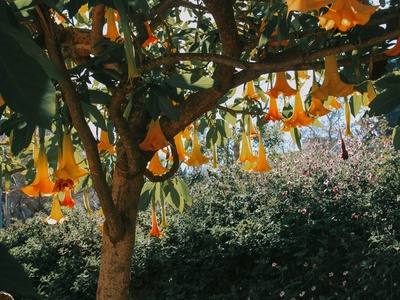
Angel’s Trumpet
Native to the Andes, this species features large, pendulous, trumpet-shaped flowers in shades of red, orange, and yellow. Unlike its fragrant relatives, it is odorless. Often seen in gardens and wilder areas around Andean towns like Baños.
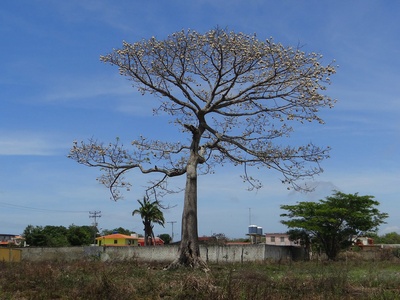
Ceibo
A remarkable tree with a swollen, spiny green trunk, it bursts into large, creamy-white flowers on bare branches during the dry season. It is a dominant species in the dry forests of Machalilla National Park on the coast.

Guayacán
Famous for its spectacular, synchronized flowering event that lasts only a few days, covering the dry forest in a blanket of brilliant yellow. The annual bloom in southern Loja province is a major ecotourism event.
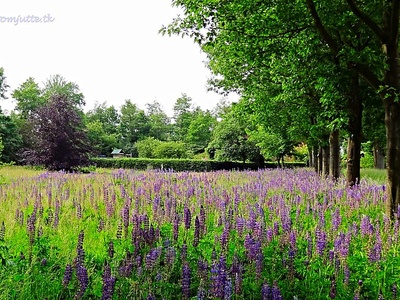
Andean Lupin
Also known as Tarwi, this plant produces stunning spires of blue, purple, and white pea-like flowers. It’s both a beautiful wildflower and an ancient crop, commonly seen growing in fields and along roadsides throughout the Sierra.
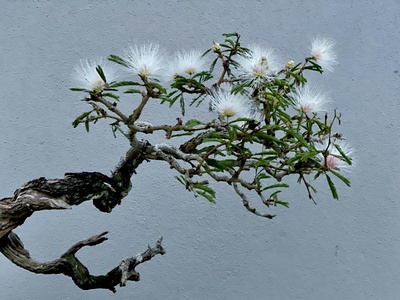
Darwin’s Daisy Tree
A unique, endemic daisy that grows into a full-sized tree, forming dense forests in the humid highlands of Santa Cruz and other islands. Its small, white, daisy-like flowers are a key part of the Galápagos ecosystem.
Lobster Claw Heliconia
This iconic tropical plant features long, hanging inflorescences with vibrant red and yellow bracts that resemble a lobster’s claw. It’s a common and dazzling sight in the Amazon rainforest, particularly around Tena and Yasuní National Park.
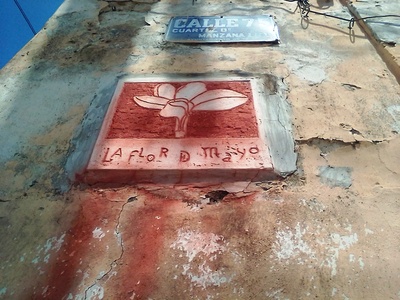
Flor de Mayo
A large, showy orchid with frilly, lavender to deep purple flowers and a distinctive yellow stripe in the throat. It grows on trees in the coastal dry forests and lower Andean slopes, and is a popular ornamental species.
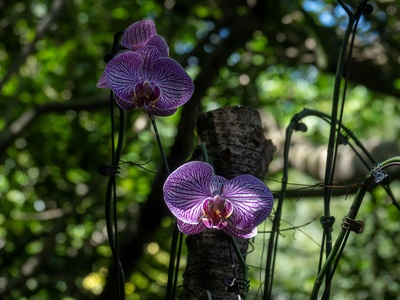
Vampire Orchid
A bizarre and sought-after orchid with large, dramatic flowers marked with blackish-purple veins against a greenish-white background. Endemic to a small area in western Ecuador, it is a flagship species for cloud forest conservation.
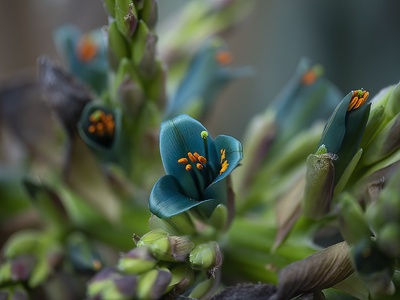
Puya
A giant terrestrial bromeliad forming large rosettes of spiny leaves. After many years, it sends up a towering flower spike up to 8 meters tall with hundreds of greenish-blue flowers, attracting birds and insects. Found in drier inter-Andean valleys.

Galápagos Cotton
An endemic shrub with bright yellow, hibiscus-like flowers that have a deep red center. It is the wild ancestor of some cultivated cottons and can be found in the arid lowlands of most islands in the archipelago.

Crucifix Orchid
One of the most common orchids in the Andes, often seen growing in large clusters on road cuts and rocky slopes. It produces a dense ball of small, typically pink or purple flowers at the top of a long cane-like stem.
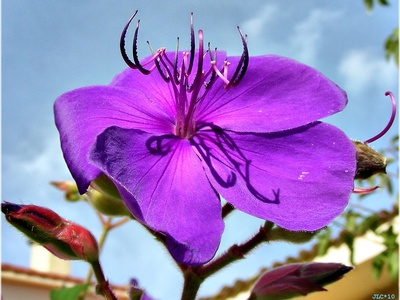
Princess Flower
This shrub or small tree is adorned with spectacular, large, deep-purple flowers that make it a standout in the cloud forest landscape. It is frequently spotted along the roadsides and forest edges in places like Mindo and Baños.

Andean Passion Flower
Known as ‘Tacso’, this high-altitude vine produces long, tubular, pink-to-red flowers pollinated by the sword-billed hummingbird. Its edible yellow fruit is a popular ingredient in juices. It drapes over vegetation throughout the Andean highlands.

Lava Cactus
A pioneer species endemic to the Galápagos, this small cactus grows in clumps directly on barren lava flows. It produces large, creamy-white flowers that open at night and last less than a day, a rare and beautiful sight.

Andean Blueberry
A low-lying shrub common in the páramo, featuring small, waxy, bell-shaped flowers that range from pink to bright red. It produces a small, edible, dark blue berry known as ‘mortiño’, essential for the traditional ‘colada morada’ drink.

Giant Andean Lily
A climbing vine from the Alstroemeria family, it produces spectacular hanging clusters of bell-shaped flowers in brilliant shades of red, orange, and yellow. It’s a favorite of hummingbirds and is often found scrambling over shrubs at forest edges.
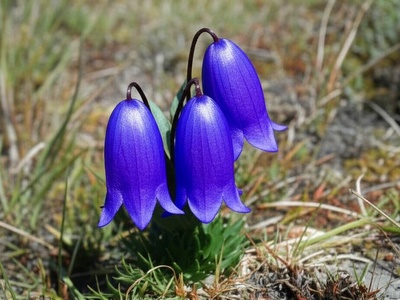
Andean Gentian
This stunning páramo herb produces nodding, bell-shaped flowers of an intense, deep blue-purple. It grows low to the ground in the high-altitude grasslands, offering a vibrant splash of color against the muted tones of the páramo landscape.

Masdevallia Orchid
A highly charismatic orchid known for its large, intensely colored flowers, which can be magenta, red, or orange. The fused sepals form a showy, kite-like shape. It grows in cool, high-altitude cloud forests, often on mossy branches.
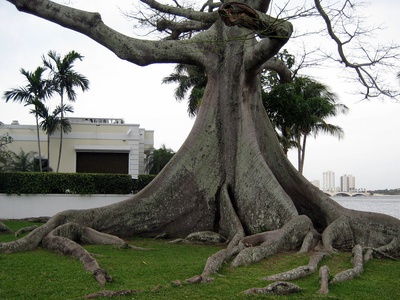
Kapok Tree
A massive tree with a buttressed trunk, its branches produce clusters of pungent, whitish-pink flowers that open at night to attract bats for pollination. The famous fluffy fiber (kapok) comes from its seed pods. It is a keystone species in tropical forests.
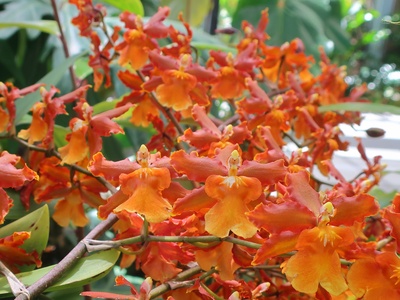
Dancing-Lady Orchid
A common and widespread group of orchids, famous for their sprays of small but numerous yellow and brown flowers. The modified lip (labellum) often resembles a skirted dancer, hence the name. They are frequently seen on trees in drier forests.

Frangipani
A small tree known for its fragrant, pinwheel-shaped flowers that can be white, pink, or yellow. Native to the dry forests of the Americas, it’s a common and beloved sight in coastal Ecuador, both wild and cultivated for its beauty.
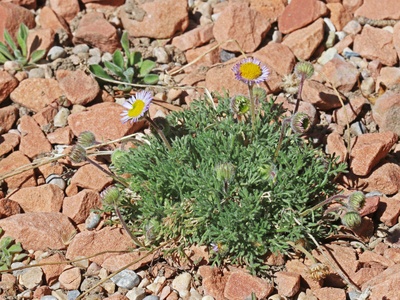
Cutleaf Daisy
One of the rarest plants in the world, this critically endangered daisy is endemic to a single island: Floreana. It has yellow, sunflower-like flowers and deeply lobed leaves. Conservation efforts are underway to save this unique Galápagos species.

Spiral Ginger
Easily identified by its spiraling stem, this plant produces a cone-like, reddish inflorescence from which delicate, white, orchid-like flowers emerge one at a time. It is a common plant on the floor of the Amazon rainforest.
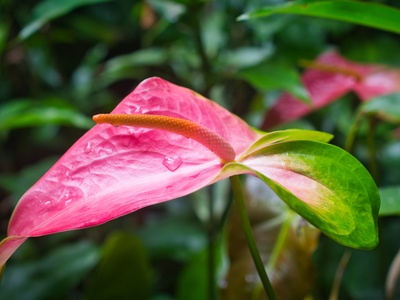
Flamingo Flower
The wild form of this popular houseplant is native to the wet forests of Ecuador and Colombia. It features a heart-shaped, typically red or pink spathe (the “flower”) and a yellow or white spadix. It grows on trees or on the forest floor.

Andean Valerian
A tall, striking herb of the páramo, reaching up to 2 meters. It creates a pyramid-shaped inflorescence composed of thousands of tiny, fragrant, white to pale pink flowers, attracting a myriad of insects. A prominent feature of the high-altitude landscape.
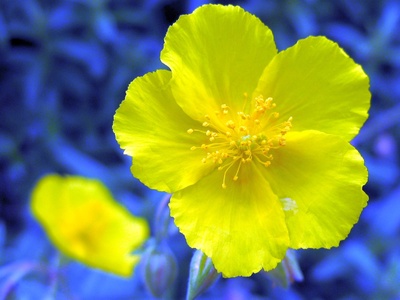
Sunrose
A small, low-growing shrub found in the dry páramo, this plant produces delicate, bright yellow flowers with five petals that resemble a small rose. It opens its flowers only in direct sunlight, tracking the sun across the sky.
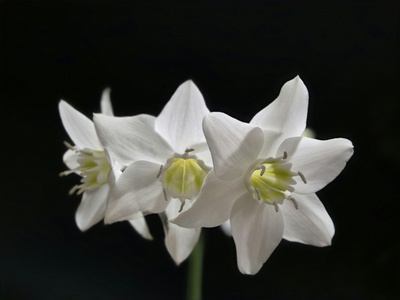
Amazon Lily
A bulbous plant from the Amazon rainforest floor, it produces stunning, fragrant white flowers that resemble daffodils. It blooms in umbels of several flowers at a time and is a popular ornamental plant worldwide, originating from this region.
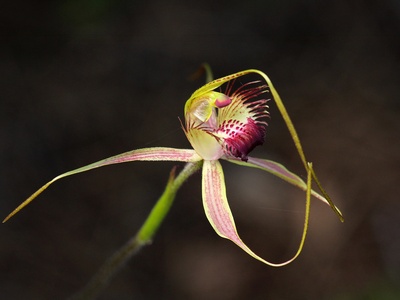
Spider Orchid
Named for its long, thin sepals and petals that resemble spider legs, this orchid has fragrant, waxy flowers, usually yellowish-green with brown or maroon spotting. It grows on tree trunks in the humid Amazon rainforest.

Galápagos Lantana
An endemic shrub that is a common sight in the arid and transition zones of the Galápagos. It produces small clusters of tiny white flowers with yellow centers, which are an important nectar source for insects, including the Galápagos carpenter bee.
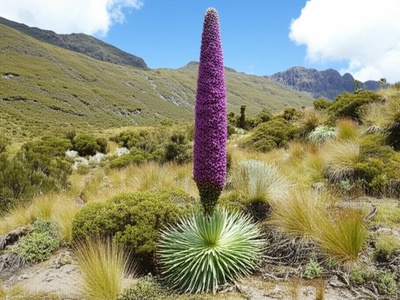
Giant Lobelia
A spectacular and bizarre plant of the high páramo, this species forms a basal rosette of leaves and then sends up a single, massive flower spike that can reach 3 meters. The spike is covered in hundreds of small, purplish flowers.
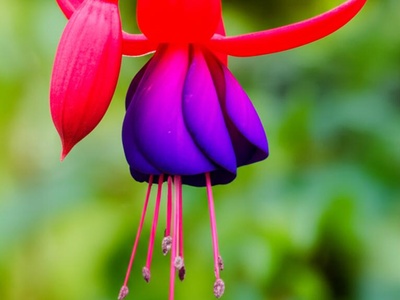
Q’uingo
A beautiful fuchsia species endemic to southern Ecuador, particularly around Loja. It has long, tubular, bicolored flowers, typically with a red tube and purple petals, perfectly adapted for pollination by hummingbirds.
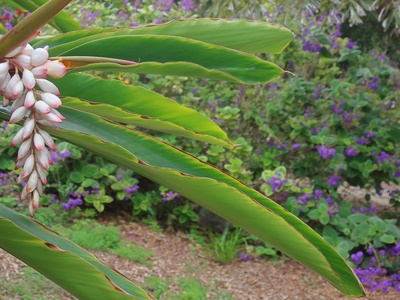
Silver-leafed Bromeliad
This small, epiphytic bromeliad (air plant) forms compact rosettes of silvery-green leaves. It produces a surprisingly large and vibrant inflorescence with bright pink or red bracts and deep purple, tubular flowers.
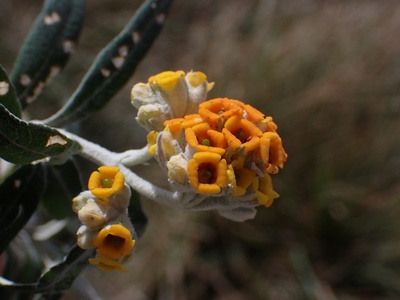
Quishuar
A native Andean tree, often called the Andean butterfly bush. It has silvery foliage and produces dense, ball-shaped clusters of small, fragrant, orange-yellow flowers that are highly attractive to pollinators. It is common in the inter-Andean valleys.
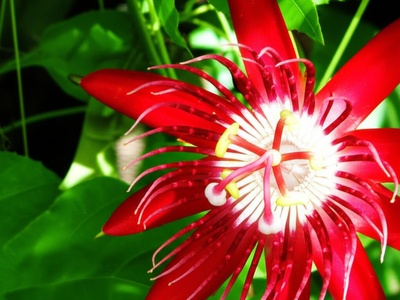
Amazon Passion Flower
This vigorous vine is found throughout the Amazon basin. It is noted for its brilliant red flowers with a filamentous corona, resembling the more common scarlet passion flower. Its striking blooms stand out against the green foliage of the rainforest.
Miconia
An endemic shrub that defines the “Miconia Zone” in the highlands of Santa Cruz and San Cristóbal. It has large, distinctive leaves and produces panicles of small, purple flowers that develop into dark berries, a key food for finches.
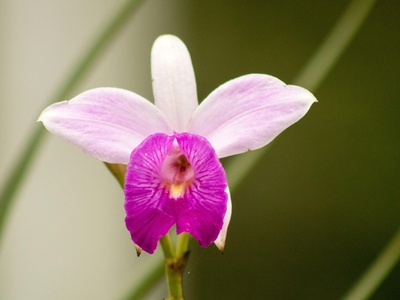
Sobralia Orchid
A stunning terrestrial or epiphytic orchid with bamboo-like stems. It produces very large, cattleya-like flowers that are typically white or pale lavender with a yellow throat. The flowers are beautiful but famously short-lived, often lasting only a day.
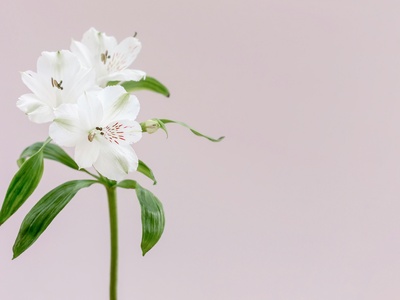
Peruvian Lily
Though its common name points to Peru, this species is native to the Andes of Ecuador as well. It has showy, trumpet-shaped flowers, typically yellow or orange with reddish spots, and is a popular cut flower worldwide.

Flor de Balsa
The flower of the famously lightweight Balsa tree. It has large, solitary, whitish flowers that open in the late afternoon and evening, attracting nocturnal pollinators like bats and moths. The tree is a fast-growing pioneer species.
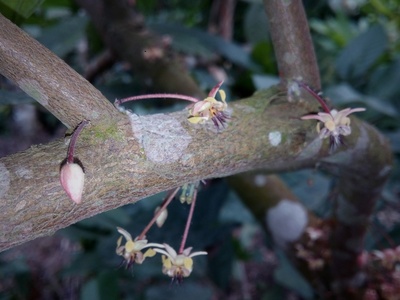
Cocoa Flower
The source of chocolate, Ecuador’s famous Arriba Nacional cacao has small, delicate flowers that grow directly from the trunk and main branches (cauliflory). They are pinkish-white and pollinated by tiny midges, a crucial step for producing cocoa pods.
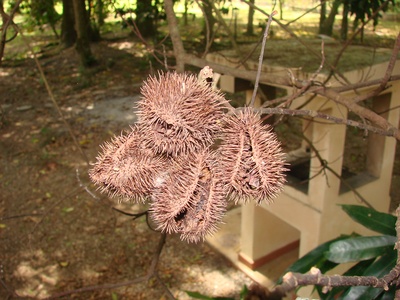
Achiote
This small tree is the source of annatto, a natural red-orange pigment. It produces attractive pinkish-white flowers with prominent yellow stamens, followed by spiky, red seed pods. It is widely cultivated and found wild in tropical lowlands.
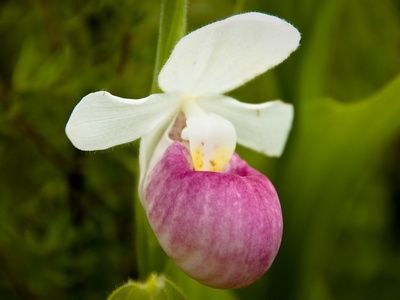
Lady’s Slipper
A rare and beautiful terrestrial orchid found in temperate zones, including isolated high-altitude pockets in the Andes. Its distinctive pouch-like petal (labellum) traps insects to ensure pollination. It is a highly protected and sought-after species.
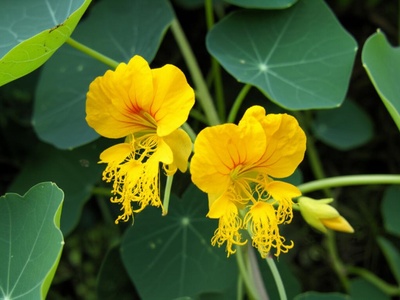
Canary Bird Vine
A climbing relative of the garden nasturtium, native to the Andes. It is prized for its uniquely shaped, bright yellow flowers with fringed upper petals that look like a canary’s wings. It scrambles over other vegetation in mid-elevation mountain habitats.

Coffee Flower
While not native, coffee is a vital part of Ecuador’s agriculture and landscape. The bushes produce beautiful clusters of fragrant, white, star-shaped flowers that resemble jasmine. The bloom is brief but intense, covering entire hillsides.

Passion Fruit Flower
The flower of the common passion fruit (‘maracuyá’), this vine produces one of nature’s most intricate blooms. It has white petals and a spectacular corona of purple and white filaments. It can be found in gardens and semi-wild areas nationwide.
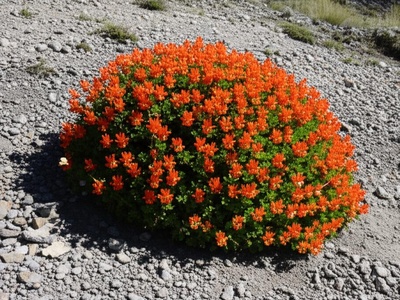
Zaragoza
A common roadside plant in the Andes, this small shrub produces sprays of small, vibrant, orange-red flowers. Each flower is “mask-shaped” with two lips, making it a cheerful and frequent sight for travelers in the Sierra.
